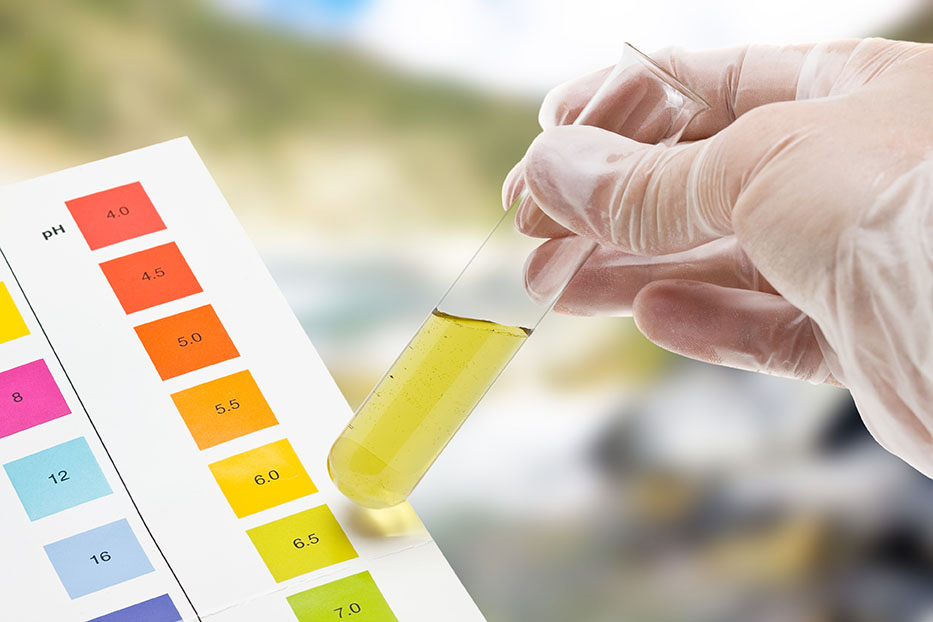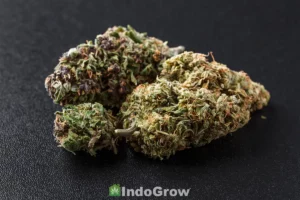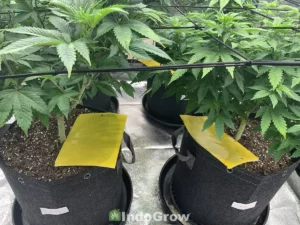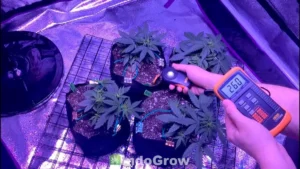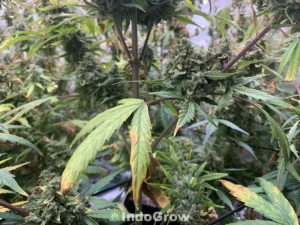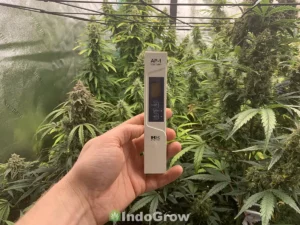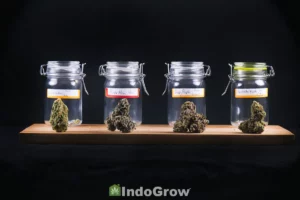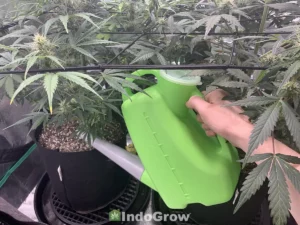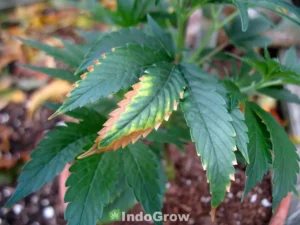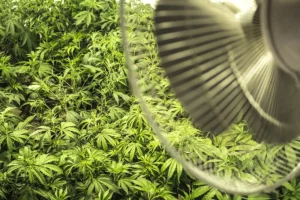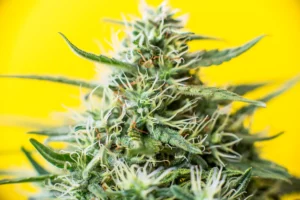Using the best pH for weed is essential for growing healthy cannabis plants. When cannabis is grown in a medium that is too acidic or too basic, the plant will experience nutrient lockout and grow sluggishly if at all. In comparison, plants grown at an ideal pH level can make the best use of the nutrients available to them to produce large, potent harvests.
In order to keep pH within optimal levels, growers will test pH levels in their soil or water regularly, then use interventions such as pH up/ pH down fluids or natural additives to correct the pH levels. Although managing pH may feel intimidating, the testing and correcting process is surprisingly simple.
Table of Contents
- What Does pH Measure?
- Why is pH Important for Cannabis?
- What are the Benefits of Balancing Your Soil Ph?
- What Should Soil pH be for Cannabis?
- How is Water pH Measured?
- How is Soil pH Measured?
- How to Raise or Lower Cannabis pH?
- What Equipment do I Need to Manage Cannabis pH?
- Best pH Meter for Growing Weed
- Summary
What Does pH Measure?
pH, which stands for power of Hydrogen, is a measure of the acidity or alkalinity of a solution. pH values are found by comparing the concentration of H+ ions vs OH- ions. Acids have higher concentrations of H+ ions, while bases have higher concentrations of OH- ions.
pH values typically range from 0 to 14, with 7 being neutral. Acidic solutions have a pH below 7, while basic solutions have a pH above 7. Cannabis, like many other plants, requires a slightly acidic growing environment to thrive.
pH is measured using a logarithmic scale where each increase or decrease of an integer changes the concentration tenfold. For example, a pH of 4 is 10 times more acidic than a pH of five, and 100 times more acidic than a pH of 6.
This quality of the pH scale means that even seemingly small changes in pH readings may have a noticeable effect on the health and vitality of your plant.
Why is pH Important for Cannabis?
pH levels will directly affect the availability of nutrients in the soil. Even if you have added appropriate levels of fertilizer to your system, the cannabis plant’s roots will not be able to take up the nutrients if the soil pH is outside the acceptable range.
Cannabis generally prefers a slightly acidic environment. In order to uptake essential macronutrients like nitrogen, phosphorus, and potassium, the soil pH should always remain above 5.5. Some nutrients, including iron, may also become too prevalent at low pH levels, and lead to toxicity in your plant.
On the other hand, a Ph above 7 will make micronutrients like iron and manganese biologically unavailable in the soil. Nitrogen also becomes progressively more difficult for plants to uptake in basic soil
What are the Benefits of Balancing Your Soil Ph?
Properly balanced pH is essential to make sure your plant does not experience nutrient lockout. pH too far outside the ideal range will make nutrients in the soil biologically unavailable to your plant, even if you are fertilizing. In fact, pH imbalance is the number one cause of nutrient deficiency symptoms in cannabis plants.
Plants grown in pH balanced soil will grow faster and have better yields with more potent buds. You may also save time and money on fertilization by making the nutrients already in the soil more available to the plant.
Plants with a pH that is too low, or acidic, may display slowed growth and discoloration of the fan leaves. PH that is too high, or alkaline, will also cause growth to slow, and new growth will typically come in pale yellow and thin. Older leaves may also begin to turn yellow.
What Should Soil pH be for Cannabis?
Like many plants, cannabis prefers slightly acidic soil. For plants growing in soil, pH should remain between 6 and 7, with 6.5 being ideal. Plants grown in soil are more forgiving of pH fluctuations than those grown in soilless systems, and pH levels as low as 5 may be tolerated for some time without damaging the plant.
Plants in hydroponic or soilless systems will need slightly more acidic conditions than those grown in soil. For these plants, pH should remain between 5.5 and 6.5, with a pH of about 6.2 being ideal.
It is ok for Ph values to vary a bit week to week, as long as they remain within range. However, chronically unstable pH levels over the lifetime of your plant will lead to a suboptimal harvest with lower yields and potency than a plant that was grown with greater stability.
Depending on the growth medium, available nutrients, and strain, different grows may have different ideal pH levels. For instance, one plant may thrive at a pH of 5.8, while the next grow appears to do best at 6.3. Some growers will gradually raise and lower the pH of a plant during the vegetative stage and record changes in its growth habit in order to determine the ideal pH for that plant.
How is Water pH Measured?
For hydroponic or other soilless grows, you can measure the pH of their water using a digital Ph testing pen or a chemical test kit before adding it to the plant. First, add any nutrients you are using to your water, then shake or stir the solution before testing. Shaking the water will mix air into the water and alter the pH slightly, so make sure to shake the water even when you are not adding nutrients to ensure you have an accurate baseline.
The type of water you use in your cannabis grow can affect your starting pH considerably. Tap or well water is the most common choice for watering plants. It can have a variety of mineral concentrations depending on your location and will typically have a pH above 7. Distilled water has no minerals or other particles in the water, but it is more expensive and also tends to have a pH slightly above 7.
Reverse osmosis water and rain water tend to have a low mineral content and a neutral pH, so they will need less alteration to achieve an ideal pH for your plants. Testing to establish a baseline and ensure that they are truly neutral is still recommended though.
How is Soil pH Measured?
The simplest way to measure soil pH is to test the runoff water after watering your plant. This water can be collected directly from the runoff tray under your plant pot, and tested using either a pH testing pen or a chemical test kit.
A more time consuming but highly accurate method of testing soil pH is the slurry method. Take a few spoonfuls of soil from the plant pot and combine with water in a 1:1 or 1:2 ratio. For the most accurate results, use the same water that you typically water the plant with.
Vigorously stir the solution until it forms a slurry, then continue to stir every five minutes or so for the next half hour. After this is finished, insert a pH testing pen into the solution to read the pH. Ideally, your soil pH will fall between 6.0 and 7.0.
To ensure that your plants remain healthy, try to test your pH levels at least once a week. Remember, it is normal for the pH to fluctuate slightly week to week, as long as it remains within healthy range.
How to Raise or Lower Cannabis pH?
Before attempting to adjust your Cannabis’ pH level, be sure to take a baseline sample of the plant’s soil or water. Many plants grown in good soil will not need any pH adjustments, while most hydroponic systems will need their pH adjusted. Regardless of your growing medium, taking a baseline sample will help you determine what products, if any, you will need to add to your water to balance the pH.
pH up and pH down control fluids are the most precise way to alter your pH, especially for hydroponics systems. Add the needed fluid to your water a few drops at a time and test it to ensure you have reached the desired pH level before watering your plant. Be sure to mix up the water thoroughly before testing, since unmixed water may give unreliable readings that are higher or lower than expected.
For plants in organic systems, growers may choose to use natural methods to adjust their plant’s pH. Products such as worm castings, compost, pine needles, and wood shavings can all lower soil pH over time. If pH is too low, lime powder or baking soda can bring it up again. When using natural additives, be sure to test the soil runoff after each watering to see if the additives are having the desired effect.
Some people used diluted lemon juice or vinegar to bring the pH down more quickly. However, this is not recommended since it is difficult to dose accurately and too much of either acid could damage the roots.
What Equipment do I Need to Manage Cannabis pH?
The first thing you will need is a pH testing pen or chemical testing kit. For the testing kit, you will also need glass vials or other clean glasses to perform the test in. These can also be used for slurry tests if you do not want to test your soil pH directly from the runoff tray.
Once you determine what alterations your soil or water needs, you will need either pH up or pH down solution. Alternately, you may use natural additives like pine needles or lime powder to raise or lower the pH over time.
Best pH Meter for Growing Weed
The most popular pH meters for growing cannabis are made by Apera Instruments. The company was been around since 1991 and makes meters and sensors of all kinds. I personally use the AI209 value series pen for checking cannabis pH.
Apera Instruments makes more advanced and expensive meters, but the value series is sufficient for most home growers. If you prefer using pH testing strips instead of a pen, then the pH test kit by General Hydroponics is the way to go.
Summary
Cannabis plants grow best in slightly acidic conditions. For cannabis in soil, the ideal pH is between 6.0 and 7.0, while for cannabis in soilless systems, a pH of 5.5 to 6.5 is preferred. Soil can provide a natural pH buffer, making fluctuations in pH less severe compared to plants grown hydroponically.
Although soilless systems require more intervention to reach ideal pH, testing and correction is simple. Simply dip a pH test stick into their water, and add a small amount of pH up or down to reach the desired pH level before watering the plant.
Soil pH can be tested using a slurry test, or by dipping a test stick directly into the runoff water reservoir. Similarly to hydroponics, pH up or down can be added to their water, or natural additives like pine needles or lime can be added directly to the soil.
Regardless of the testing and correction methods you choose, a pH balanced plant will reward you with fast growth and a bountiful harvest.

Rocky Horton
Author
Rocky Horton is an experienced cannabis grower and the founder of IndoGrow. The IndoGrow editorial team has over four decades of combined growing experience. Learn more.

